SIU Director’s Report - Case # 17-TCI-133
Warning:
This page contains graphic content that can shock, offend and upset.
Contents:
Mandate of the SIU
The Special Investigations Unit is a civilian law enforcement agency that investigates incidents involving police officers where there has been death, serious injury or allegations of sexual assault. The Unit’s jurisdiction covers more than 50 municipal, regional and provincial police services across Ontario.
Under the Police Services Act, the Director of the SIU must determine based on the evidence gathered in an investigation whether an officer has committed a criminal offence in connection with the incident under investigation. If, after an investigation, there are reasonable grounds to believe that an offence was committed, the Director has the authority to lay a criminal charge against the officer. Alternatively, in all cases where no reasonable grounds exist, the Director does not lay criminal charges but files a report with the Attorney General communicating the results of an investigation.
Information restrictions
Freedom of Information and Protection of Personal Privacy Act (“FIPPAâ€)
Pursuant to section 14 of FIPPA (i.e., law enforcement), certain information may not be included in this report. This information may include, but is not limited to, the following:
- Confidential investigative techniques and procedures used by law enforcement agencies; and
- Information whose release could reasonably be expected to interfere with a law enforcement matter or an investigation undertaken with a view to a law enforcement proceeding.
Pursuant to section 21 of FIPPA (i.e., personal privacy), protected personal information is not included in this document. This information may include, but is not limited to, the following:
- subject officer name(s)
- witness officer name(s)
- civilian witness name(s)
- location information
- witness statements and evidence gathered in the course of the investigation provided to the SIU in confidence and
- other identifiers which are likely to reveal personal information about individuals involved in the investigation
Personal Health Information Protection Act, 2004 (“PHIPAâ€)
Pursuant to PHIPA, any information related to the personal health of identifiable individuals is not included.
Other proceedings, processes, and investigations
Information may have also been excluded from this report because its release could undermine the integrity of other proceedings involving the same incident, such as criminal proceedings, coroner’s inquests, other public proceedings and/or other law enforcement investigations.
Mandate engaged
The Unit’s investigative jurisdiction is limited to those incidents where there is a serious injury (including sexual assault allegations) or death in cases involving the police.
“Serious injuries†shall include those that are likely to interfere with the health or comfort of the victim and are more than merely transient or trifling in nature and will include serious injury resulting from sexual assault. “Serious Injury†shall initially be presumed when the victim is admitted to hospital, suffers a fracture to a limb, rib or vertebrae or to the skull, suffers burns to a major portion of the body or loses any portion of the body or suffers loss of vision or hearing, or alleges sexual assault. Where a prolonged delay is likely before the seriousness of the injury can be assessed, the Unit should be notified so that it can monitor the situation and decide on the extent of its involvement.
This report relates to the SIU’s investigation into the serious injury reportedly sustained by a 25-year-old man during his arrest on May 30th, 2017.
The investigation
Notification of the SIU
At approximately 3:40 a.m. on Wednesday, May 31st, 2017, the Toronto Police Service (TPS) notified the SIU of a custody injury that occurred around 10:17 p.m. on the previous night.
The Team
Number of SIU Investigators assigned: 3
Number of SIU Forensic Investigators assigned: 1
Two SIU investigators and one forensic investigator were assigned and dispatched, arriving at the scene at 6:16Â a.m. Another SIU investigator was assigned after the initial dispatch.
SIU forensic investigators responded to the scene and identified and preserved evidence. They documented the relevant scenes associated with the incident by way of notes, photography, and measurements. The Complainant’s injuries were also photographed.
Complainant:
25-year-old male, interviewed, medical records obtained and reviewed
Civilian Witnesses
CWÂ #1 Interviewed
CWÂ #2 Interviewed
CWÂ #3 Interviewed
Witness Officers
WOÂ #1 Notes reviewed, interview deemed not necessary
WOÂ #2 Interviewed
WOÂ #3 Interviewed
WOÂ #4 Interviewed
WOÂ #5 Interviewed
WOÂ #6 Interviewed
WOÂ #7 Interviewed
WOÂ #8 Notes reviewed, interview deemed not necessary
Subject Officers
SOÂ #1 Interviewed, and notes received and reviewed
SOÂ #2 Interviewed, and notes received and reviewed
Incident narrative
On May 30th, 2017, members of the Major Crime Unit (MCU) of the TPS were attempting to apprehend various parties, including the Complainant, who had outstanding arrest warrants. The Complainant was eventually located on Gerrard Street in the City of Toronto, but he ran from police.
At about 11:00Â p.m., police officers again located the Complainant in the area of Enderby Road and Gerrard Street. While officers gave pursuit, on foot, the Complainant ran and fell over an angle iron in the roadway, and fell onto the ground, without any other police officer coming into physical contact with him. When he fell, some of his personal property went flying and the battery from his cell phone was later located by SIU investigators in this area.
The Complainant then got back up and continued to run, scaling a number of fences in his bid to escape. SOÂ #2 eventually located the Complainant scaling a fence, about 1.5 metres in height, and ordered the Complainant to get down. When he refused to do so, SOÂ #2 grabbed onto his legs in a bear hug type manoeuvre and held on, until SOÂ #1 arrived and assisted him in removing the Complainant from the fence. The Complainant alleges that SOÂ #2 then started to punch the Complainant in the ribs, until he let go of the fence. He further alleges that a bunch of police officers then piled on him and kneed him and he could not breathe, and, at one point, he felt his foot snap.
The Complainant was later taken to hospital.
Nature of Injuries / Treatment
The medical record noted that the Complainant was diagnosed with a navicular fracture and a fracture of the first metatarsal of his right foot.
Evidence
The Scene
MCU police officers initially saw the Complainant in the courtyard between two apartment buildings on Kingston Road and became involved in a foot pursuit in the area between the buildings. The buildings, located on the north side of Kingston Road, share a common landscaped courtyard between them that includes a sitting area with a picnic table and benches. The landscape descends toward the rear of the properties to the north.
Along the sodded area there is a concrete-paved foot path. The concrete path ends with a curb where the parking lot begins. At the north end of the concrete path, a length of metal angle iron was bolted to the concrete. The 3.6 metre long angle iron was painted yellow and rose about nine centimetres above the concrete. It appeared the angle iron was installed to stop caster-mounted garbage bins from rolling downhill, off the walkway, and into the parking lot.
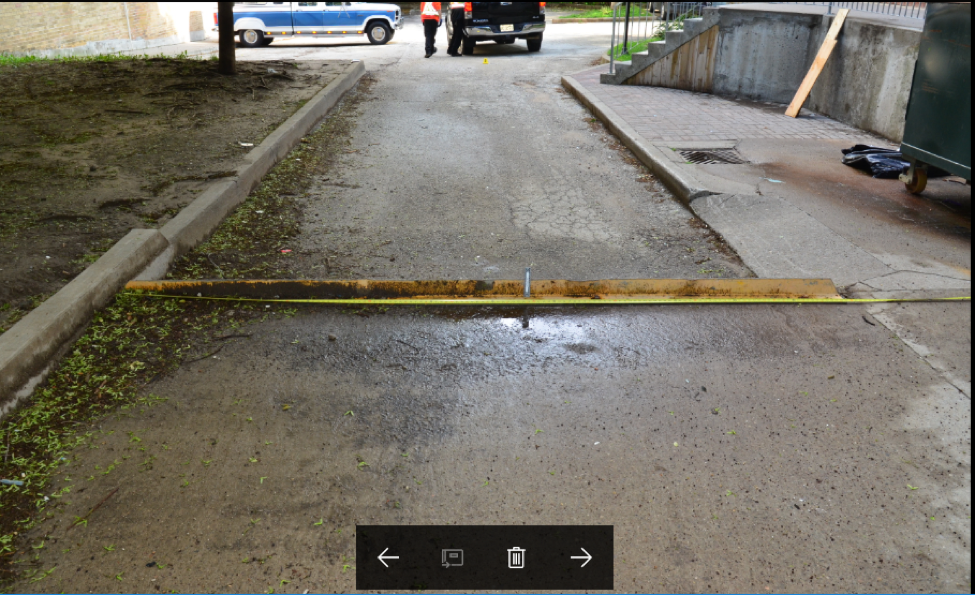
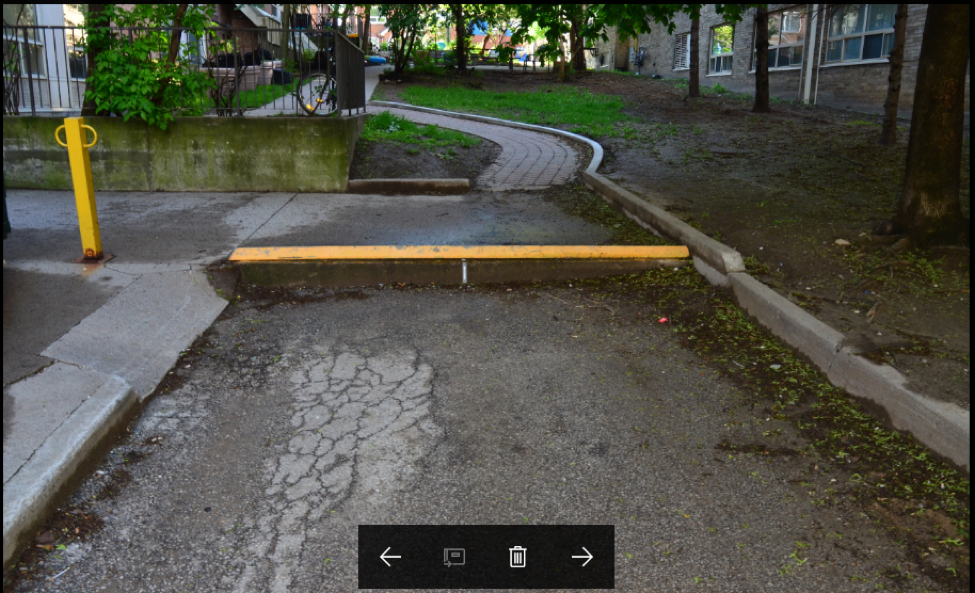
In the immediate area north of the angle iron, SIU investigators found a cellular phone battery. The battery was a model consistent to that in the Complainant’s cellular phone.
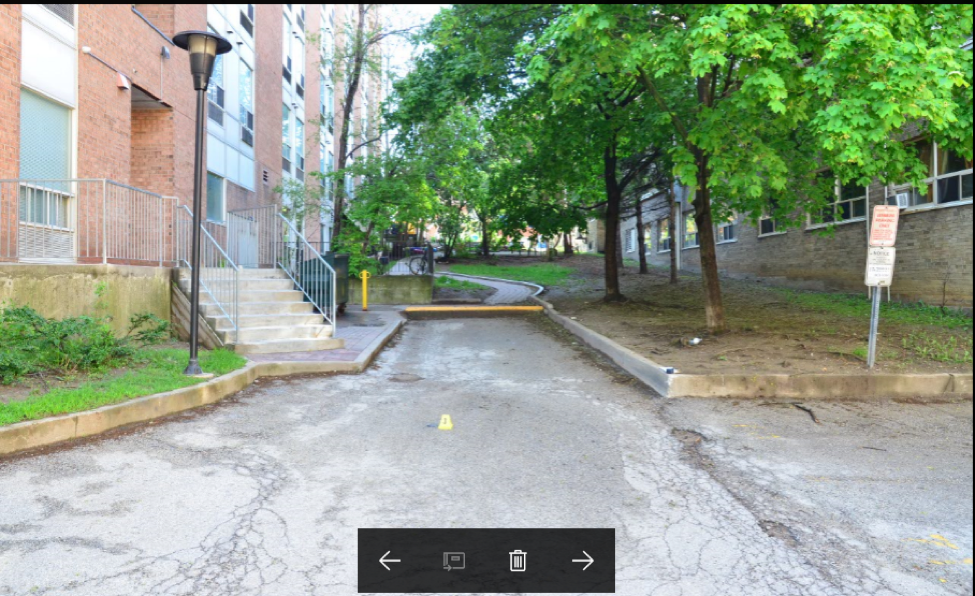
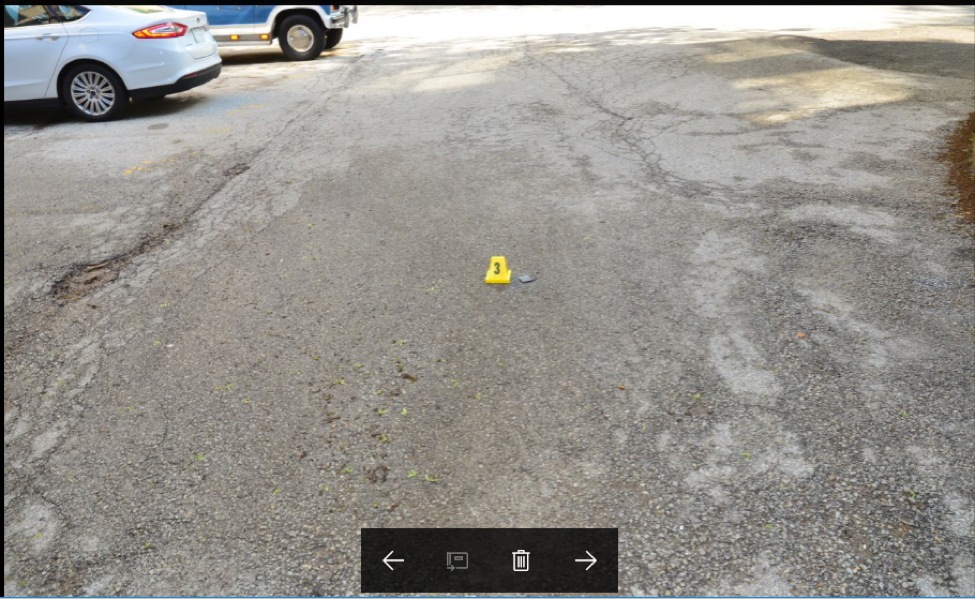
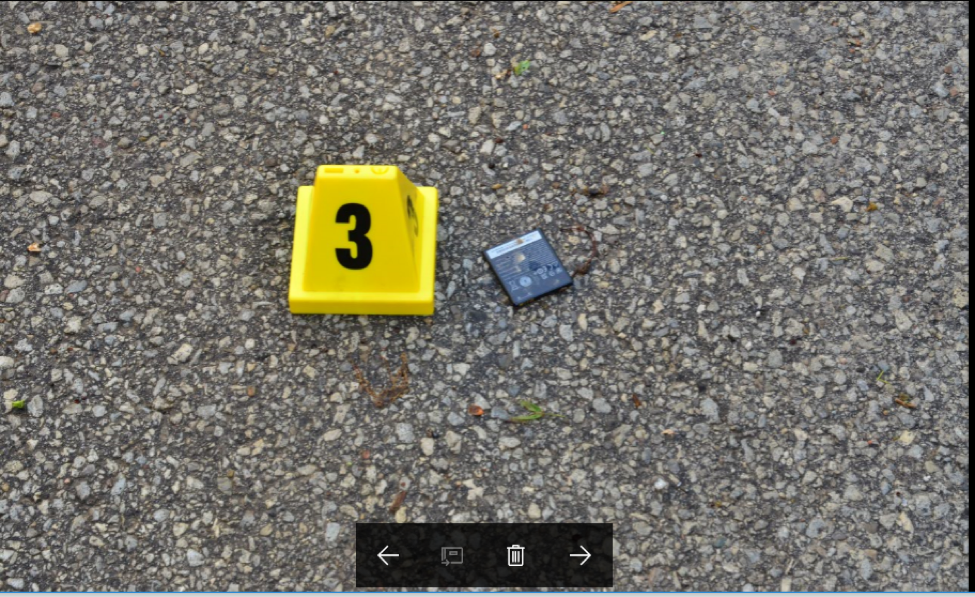
The scene of arrest was also examined by the SIU.
The Complainant was arrested in a laneway between Norwood Road to the west and Enderby Road to the east, south of Gerrard Street East. At the east side of the laneway, the Complainant tried to scale the fence at the rear of a home on Enderby Road. The wood fence was measured to be about 1.5 metres high. In that area, a white, right Nike running shoe was observed on the ground. The shoe was the same style as the left shoe worn by the Complainant when he was interviewed by the SIU. The Complainant’s right foot was casted and he did not know the whereabouts of his right shoe.
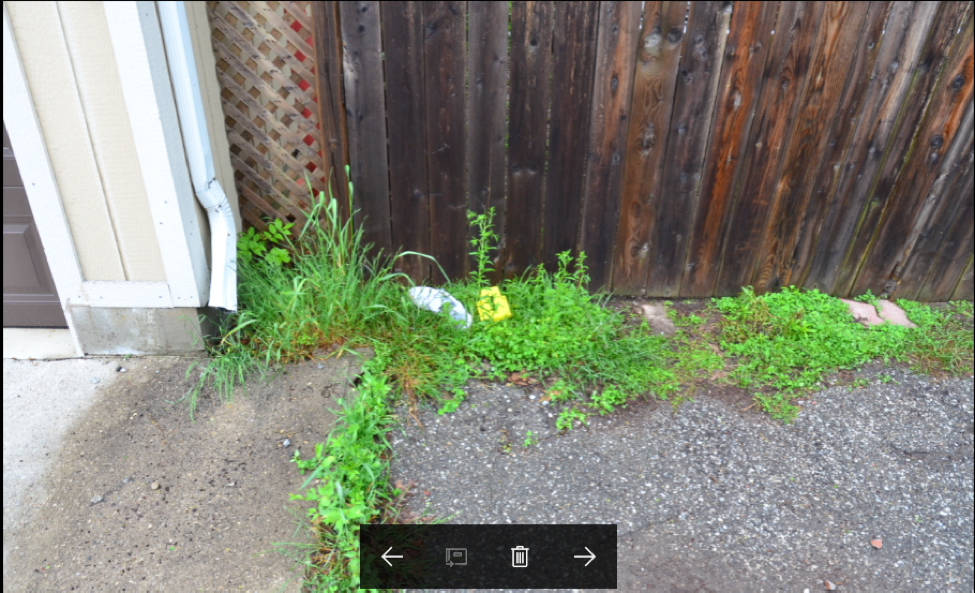
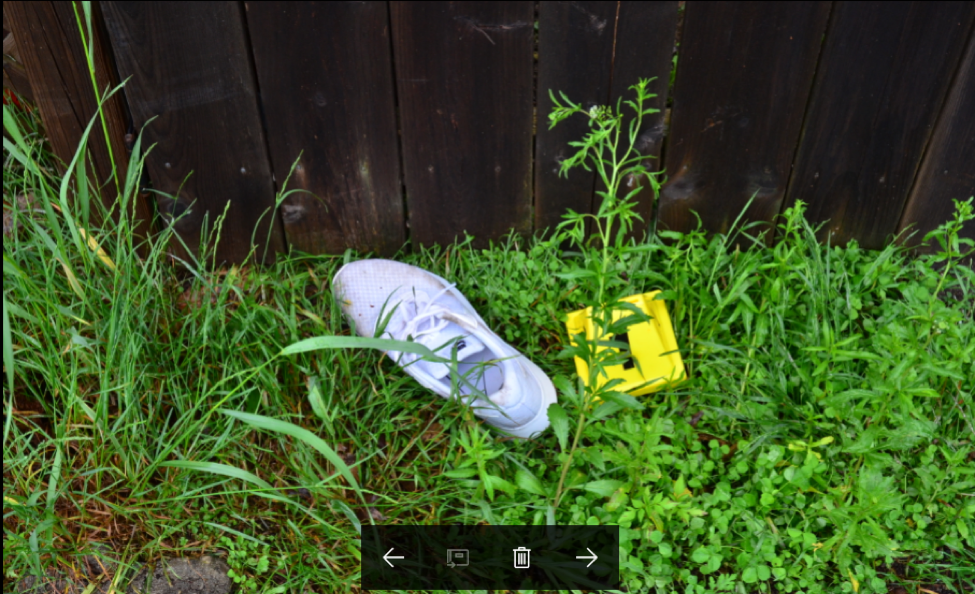
Forensic Evidence
No submissions were made to the Centre of Forensic Sciences.
Video/Audio/Photographic Evidence
A canvass of the surrounding area revealed a security camera mounted on the northwest exterior wall of a building on Kingston Road. The property management company released a copy of a recording to the SIU but the recording was from another camera on the property. By the time the error was addressed, the recording equip.m.ent’s retention period had elapsed and recordings from the night of this incident had been overwritten.
In Car Camera System (ICC) Recording:
The recording from WO #6’s cruiser revealed that on three occasions the Complainant told the transporting police officers, “I broke my foot,†and that “it hurt when I fell.â€
Communications Recordings
Communications Recordings:
The communications recordings captured a series of transmissions by police officers describing their observations into CW #2’s apartment.
Once the people in the apartment exited the building, a police officer reported over the radio that the trio and a child were walking up the east side of the building, toward Kingston Road and that he thought the male was the Complainant.
In a subsequent transmission a police officer reported, “Yea, we got a foot pursuit boys.â€
When one police officer asked WO #5, “What’s the direction of travel?†he reported that he had no idea as they disappeared at Kingston Road, while he was getting the Complainant’s cellular phone.
A female police officer, now known to be SO #1, asked for a description of the Complainant’s clothing, in response to which WO #5 then provided a description.
In a later transmission, WO #5 reported that he believed he was the only member carrying a “mitre.â€[1]
Police officers then transmitted a series of reports of sightings of the Complainant.
Shortly after a male police officer reported, “He’s at the first street west of Main,†SO #1 was short of breath as she reported, “One in custody.†After other police officers asked for their location, SO #1 reported that a cruiser was already there.
Materials obtained from Police Service
Upon request, the SIU obtained and reviewed the following materials and documents from the TPS:
- Event Details Reports
- General Occurrence
- Injury Illness Report
- Notes of WOÂ #s 1-8 and both SOs
- Seized Property List
- Summary of Conversation
- TPS Booking Photo
- TPS Photos
- Police Communications Recordings
- In Car Camera video
- TPS Fullcases
The SIU also obtained and reviewed the medical records of the Complainant.
Relevant legislation
Section 25(1), Criminal Code - Protection of persons acting under authority
25 (1) Every one who is required or authorized by law to do anything in the administration or enforcement of the law
- as a private person
- as a peace officer or public officer
- in aid of a peace officer or public officer, or
- by virtue of his office
is, if he acts on reasonable grounds, justified in doing what he is required or authorized to do and in using as much force as is necessary for that purpose.
Analysis and director’s decision
On May 30th, 2017, members of the Toronto Police Service (TPS) working in the Major Crime Unit (MCU) were tasked with apprehending a number of persons who were wanted on outstanding warrants of arrest; one such person was the Complainant. The Complainant was located by police in a courtyard located between two apartment buildings on Kingston Road in the City of Toronto and chose to flee from police. After a significant foot pursuit, involving scaling and/or jumping over various fences, the Complainant was located by SO #1 and SO #2. After the Complainant was pulled down from a fence that he was in the process of scaling, he was arrested and then transported to hospital where he was diagnosed with a navicular fracture (fracture of a bone located on the inner side of the foot just above the arch) and a fracture of the first metatarsal (the bone leading to the big toe) of his right foot.
The Complainant alleges, that while being pursued on foot by police, he was scaling a fence when SOÂ #2 grabbed his legs and held onto him, telling him to let go. When he did not, SOÂ #2 started to punch him in the ribs, and he let go. He further alleges that a bunch of police officers then piled on him and kneed him and he could not breathe, and, at one point, he felt his foot snap.
WO #2, one of the initial police officers who approached the Complainant, advised that he believed that the Complainant had seen his police radio, which twigged him to the fact that he was a police officer. The Complainant then quickly turned and ran with WO #2 yelling, “Police, stop!†WO #2 then observed the Complainant trip on something and fall hard to the pavement. WO #2 advised that no police officer made any physical contact with the Complainant at the time that he fell. This evidence is confirmed by the Complainant.
The Complainant then quickly stood and continued running and WOÂ #2 pursued him, but never closed the gap to less than five feet. WOÂ #2 observed the Complainant jump over a number of fences and, at one point, he observed the Complainant land on the roof of a garage or carport on the other side of a fence. When WOÂ #2 then jumped the same fence, he fell about ten feet to the ground and lost sight of the Complainant. After the Complainant had been arrested, SOÂ #2 told him that he had grabbed onto the Complainant as he scaled a fence, leading to his arrest.
WOÂ #3, who was partnered with WOÂ #2, indicated that he saw the Complainant run and then fall forward, landing on the pavement and losing some of his property. He advised that no police officer was close enough to the Complainant to have caused him to trip and fall.
WO #4, who was approaching the Complainant from the opposite side, advised that he observed the Complainant running “full tilt†from the police officers, when his right foot got caught on an angle iron in the ground and he flew through the air and then landed on the ground, dropping some of his personal property in the process. WO #4 advised that he then approached the Complainant with his arms extended in order to tackle him, but that he missed and the Complainant again fled. WO #4 spoke with SO #2 after the arrest, and SO #2 advised him that he caught the Complainant as he tried to scale a fence, and that he grabbed him by the legs and held him in a bear hug until SO #1 arrived, when they pulled him off the fence. Aside from pulling him off the fence, SO #2 advised that neither officer used any force to arrest the Complainant.
WOÂ #5 advised that he observed the Complainant trip on the angle iron bolted to the ground and fly through the air and land on the pavement, after which he immediately stood and ran. WOÂ #5 indicated that no police officer was involved in tripping the Complainant.
SO #2 advised that he was at the station with his partner, SO #1, when he heard over the police radio that there was a foot pursuit in progress for the Complainant, and they drove to the area to assist. At 10:50 p.m., SO #2 observed the Complainant walking in the park, in their direction, and he and SO #1 waited for him. When the Complainant was about ten feet away, SO #1 identified himself as police, showed his badge, and told the Complainant to stop, as he was under arrest. The Complainant then briefly stared at SO #2, following which he turned and ran. SO #2 gave chase but never got closer than 10 to 15 feet of the Complainant, until the Complainant tried to jump a wooden fence that was approximately six feet tall. The Complainant was bent over the fence at the waist when SO #2 grabbed him by the legs. SO #2 held the Complainant’s shins in a bear hug with both arms and tried to pull him down off the fence in a jerking fashion while the Complainant continued to resist and struggled to get over the fence. SO #2 described this as a stalemate and they stayed in this position for approximately 45 seconds, until SO #1 arrived and the Complainant let go and gave up.
SO #2 advised that he was the only police officer to have his hands on the Complainant, other than SO #1 who possibly grabbed one of his legs as he was lowered to the ground. The Complainant was then placed on his stomach and handcuffed with his hands behind his back, following which he walked to a police cruiser that had just arrived. SO #2 advised that no police officers ever got on top of the Complainant and, although the Complainant did say that he could not breathe, SO #2 simply took that to mean that he was out of breath from running. SO #2 advised that he did not see anything occur that could have accounted for the Complainant’s injury.
SO #1 advised that while SO #2 was chasing the Complainant, she was lagging a bit behind and was updating dispatch by way of her radio. She observed the Complainant run to a wooden fence and try to scale the fence when SO #2 grabbed the Complainant. SO #1 described the Complainant’s mid-section as resting on top of the fence with his hands on either side, while SO #2 held him by the ankles in a bear hug. When WO #1 caught up, she took hold of the Complainant’s upper body and he was brought to the ground where he was handcuffed with his hands behind his back. The Complainant then complained that he had defecated and that his ankle hurt.
WOÂ #7 and WOÂ #6 advised that they received information about a foot pursuit and that the Complainant was located in a laneway near Norwood Avenue, and they drove to that area in their police cruiser. Upon arrival, both officers advised that the Complainant was already on the ground, on his chest, and handcuffed with his hands behind his back. Other than SOÂ #1 and SOÂ #2, no other police officers were present. WOÂ #6 took custody of the Complainant and placed him in the cruiser with the in-car camera (ICC) system activated. WOÂ #6 advised that en route, the Complainant complained that his foot was sore but made no complaints of mistreatment by police officers. Once at the hospital, WOÂ #6 advised that the Complainant told his partner and himself that that he did not blame the police for his injury as it occurred when he had jumped over a fence. WOÂ #7 advised that he overheard the Complainant provide this same explanation to both a hospital employee and the triage nurse.
The ICC footage retrieved from the cruiser of WOÂ #6 and WOÂ #7 confirms that while in the cruiser, on three different occasions, the Complainant informed the officers that he broke his foot and that it was hurt when he fell.
In the medical records of the Complainant, the attending physician noted that the Complainant had advised: “that when he fell to the ground he developed a pain in his side and his footâ€. The triage notes indicate that the Complainant told them that he had been drinking and had consumed both Crystal Methamphetamine as well as Cocaine and that he “jumped from fence and injured right footâ€.
Additionally, the attending physician opined that the injury to the Complainant’s foot was not consistent with being ‘stomped on,’ but rather is an injury typically sustained by falling from a height, such as jumping over a fence.
I accept the evidence of the Complainant that he was not tripped by a police officer, nor was any police officer in physical contact with him when his right foot got caught on the angle iron causing him to fall hard on the pavement. This evidence is corroborated by the four initial police officers who pursued and attempted to arrest the Complainant. However, based on the evidence of the Complainant’s utterances to police and medical staff that he injured his foot when he fell, which utterances were captured in the ICC video footage and the medical records, I reject his evidence that a number of police officers “piled†on him following his apprehension, as a result of which he felt his foot snap. I find this conclusion is supported by the police transmissions recording which revealed that only SO #2 and SO #1 were present at the time of the Complainant’s arrest, and by the utterances made by both SO #2 and SO #1, to their fellow officers, that the Complainant’s apprehension only involved removing him from the fence and that no other physical force was used, other than the minimum required to put him to the ground and handcuff him. Finally, I find that the medical opinion that an injury such as that suffered by the Complainant was typically sustained in a fall from a height, and was not consistent with being stomped on, fully discredits the version of events as proffered by the Complainant and corroborates the evidence of the various police witnesses.
Pursuant to section 25(1) of the Criminal Code, police officers are restricted in their use of force to that which is reasonably necessary in the execution of a lawful duty. Turning first to the lawfulness of the Complainant’s apprehension, it is clear that police officers had reasonable grounds to apprehend the Complainant based on his many outstanding arrest warrants. As such, the pursuit and apprehension of the Complainant was legally justified in the circumstances.
With respect to the amount of force used by officers to apprehend the Complainant, I find that WOÂ #2, WOÂ #3, WOÂ #4, and WOÂ #5 had no physical contact with the Complainant whatsoever and no officer was involved in his tripping over the angle iron and falling hard onto the ground.
With respect to SO #2 and SO #1, I find that they used no more force than required to get the Complainant down from the fence, which involved SO #2 grabbing and holding the legs of the Complainant in a bear hug, until the Complainant decided to let go of the fence and gave up. Once the Complainant had been removed from the fence, I find that both SO #2 and SO #1 used no more than the minimal force required to place the Complainant onto his stomach on the ground and to handcuff him with his hands behind his back. As indicated above, I find that this version of events is fully confirmed by the Complainant’s various utterances made both on the ICC video and recorded on his medical records and his absolute silence with respect to any complaints made either in the police cruiser or at the hospital with respect to any mistreatment that he had received at the hands of police. While the Complainant had every opportunity to advise either the attending physician or the nursing staff that police had caused his injury, he did not do so, instead stating repeatedly that he had fallen while being pursued by police.
While it may be that had police not pursued the Complainant, he may not have been injured, the police cannot be held responsible for the actions of the Complainant in fleeing and jumping over several fences in his lengthy foot pursuit in order to evade apprehension for his various outstanding warrants. Police were duty bound to apprehend the Complainant and the Complainant was not entitled to thwart that duty by running. Furthermore, while I am unable to determine when exactly the Complainant sustained his injury, I have no difficulty finding that it occurred either when he fell over the angle iron or when he was jumping one of the many fences that he did in order to evade police.
In conclusion, I find on all of the credible evidence that no force other than the minimal amount required to bring the Complainant down from the fence and to handcuff him was used by either SOÂ #2 or SOÂ #1, and that there are no reasonable grounds upon which to believe that either police officer employed an excessive use of force against the Complainant, nor that they were the cause of his injuries and, as such, there is no evidence upon which to base a reasonable belief that a criminal offence was committed here.
Date: March 19, 2018
Original signed by
Tony Loparco
Director
Special Investigations Unit
Endnotes
- 1) [1] Portable 2-way radio. [Back to text]
Note:
The signed English original report is authoritative, and any discrepancy between that report and the French and English online versions should be resolved in favour of the original English report.
